The Swansea City academy has seen an abundance of talented players graduate from its ranks. The likes of Joe Allen, Ben Davies, and Connor Roberts are all products of the academy. Allen’s tenacious midfield displays propelled him to the illustrious ranks of Liverpool and later to Stoke City before returning to Swansea in 2022. Ben Davies has made his mark at Tottenham Hotspur with some impressive performances. Meanwhile, Connor Roberts, with his marauding runs down the right flank and resolute defensive contributions, earned himself a move to Burnley and played a crucial role in their promotion to the Premier League last season.
The Swans are currently playing their football in the EFL Championship as they seek to build a team that can once again challenge for promotion. There is a youth academy graduate at the heart of the current Swansea City first team in the form of Ben Cabango, indicating that the club is still producing wonderfully talented players.
This tactical analysis will take the form of a scout report where we highlight three players in the Swansea City youth ranks who have been putting in some standout performances this season. We will look at how they fit into Swansea Under 18s tactics and what each player brings via his individual style of play.
Arthur Parker
The first player we are going to look at in this analysis piece is Arthur Parker. The 17-year-old is a right-footed centre-back who can play in either a back four or a back three or as a defensive midfielder. Firstly, we will highlight his ball-playing abilities, as this is an area where the young defender really shines.
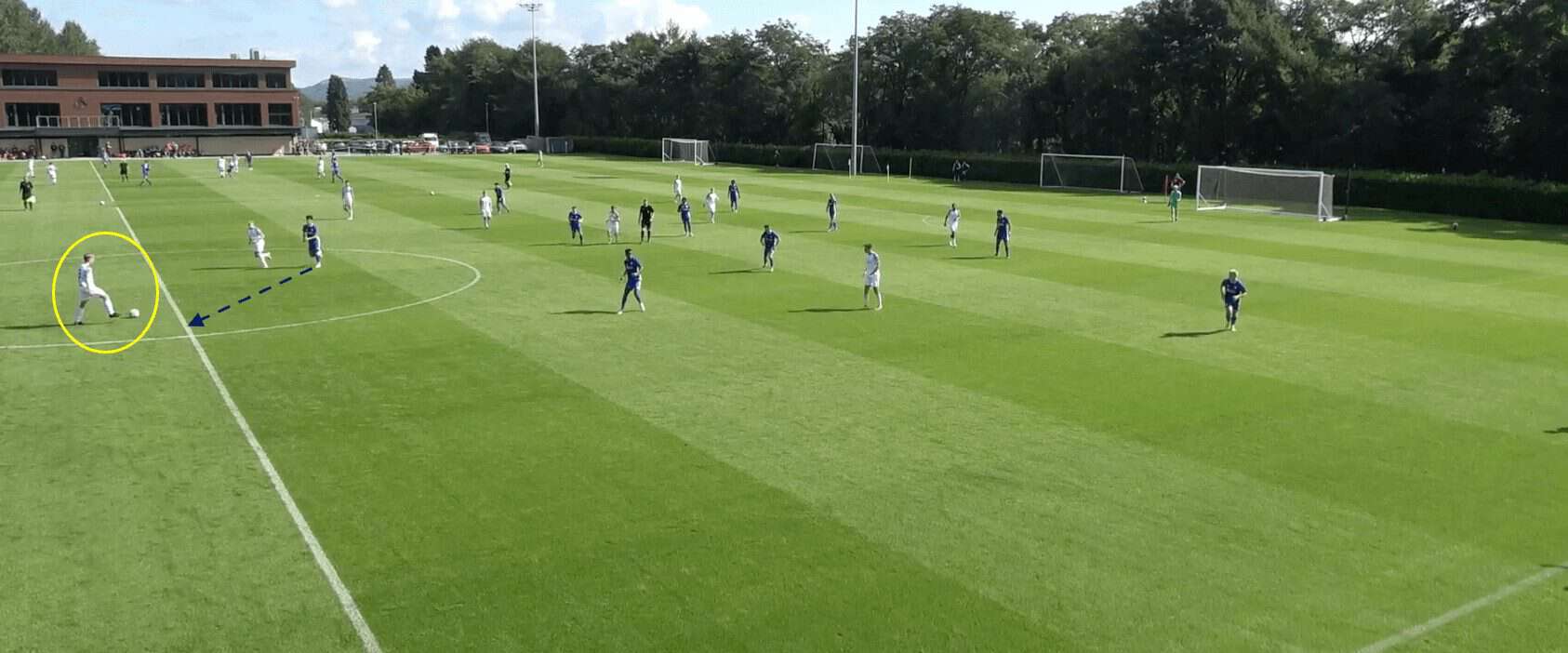
As we know, modern-day defenders are very much expected to be able to play out from the back and be the catalyst as the team looks to build an attack. Arthur Parker is calmness personified when in possession. In this scenario, he receives the ball and displays an excellent first touch whilst continuously scanning and assessing what is going on around him on the pitch.
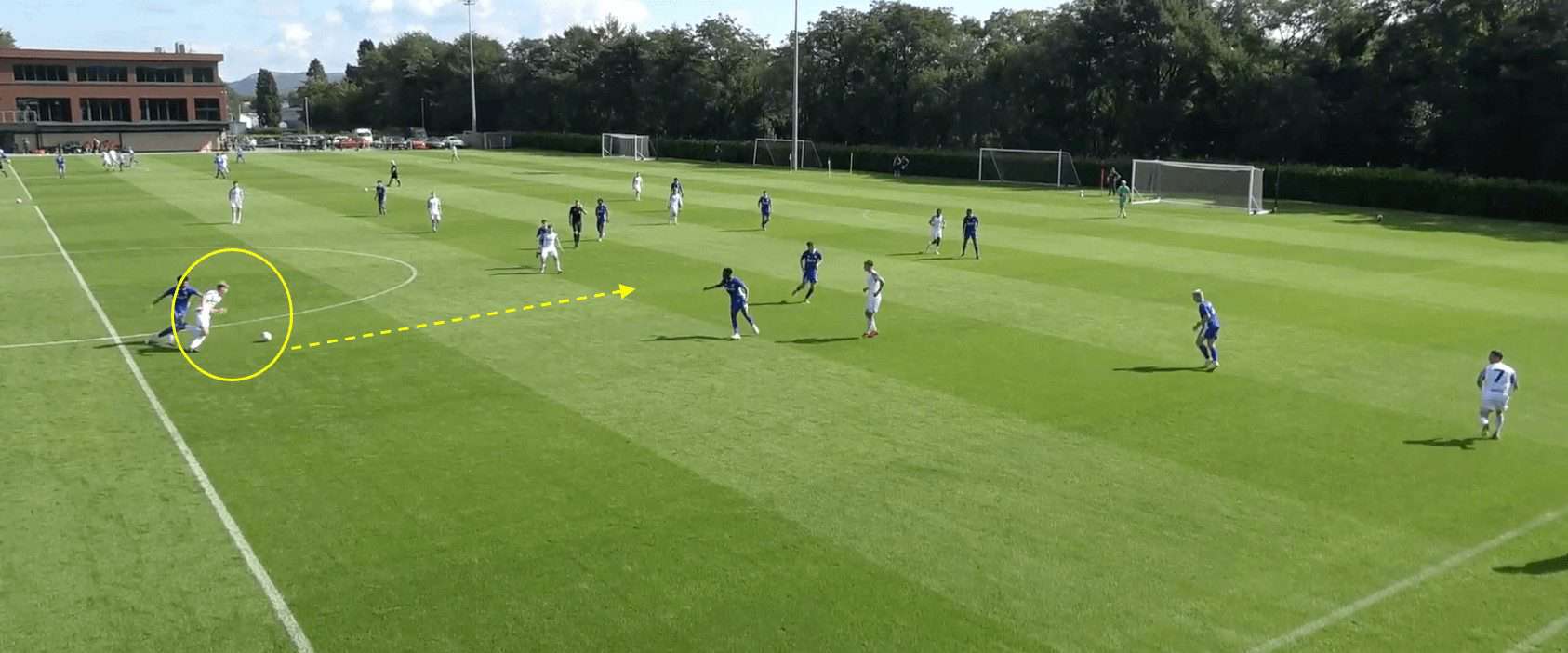
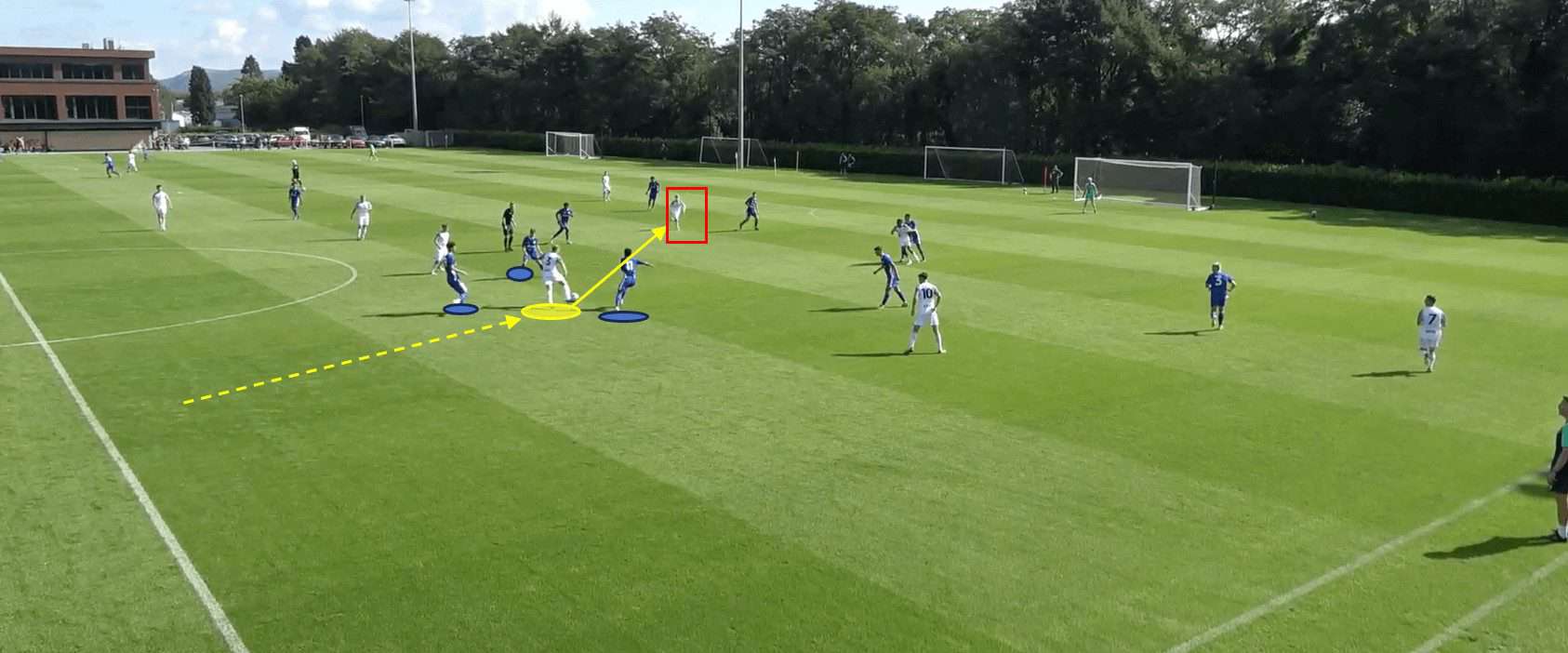
Parker is put under pressure due to the opposition forward pressing him, looking to turnover possession high up the pitch and launch a counterattack. The Swansea City centre-back easily adapts to this situation and calmly sidesteps and plays the ball beyond the pressing forward. This is an element of his game he uses quite frequently, averaging 1.51 take-ons per 90 and with a 90% pass accuracy. Hence, he is reliable when picking out his teammates.
He then carries the ball forward into space, which draws three opponents around him, leaving his Swansea teammates in plenty of space. Parker then releases the ball to his teammate, highlighted in red. By building attacks from the defensive line, the young centre-back becomes an integral part of the team’s build-up play, facilitating a much easier transition from defence to offence. This approach allows Swansea to exert greater control over the tempo of the game, enabling them to maintain possession and dictate the flow of play from the build-up phase.
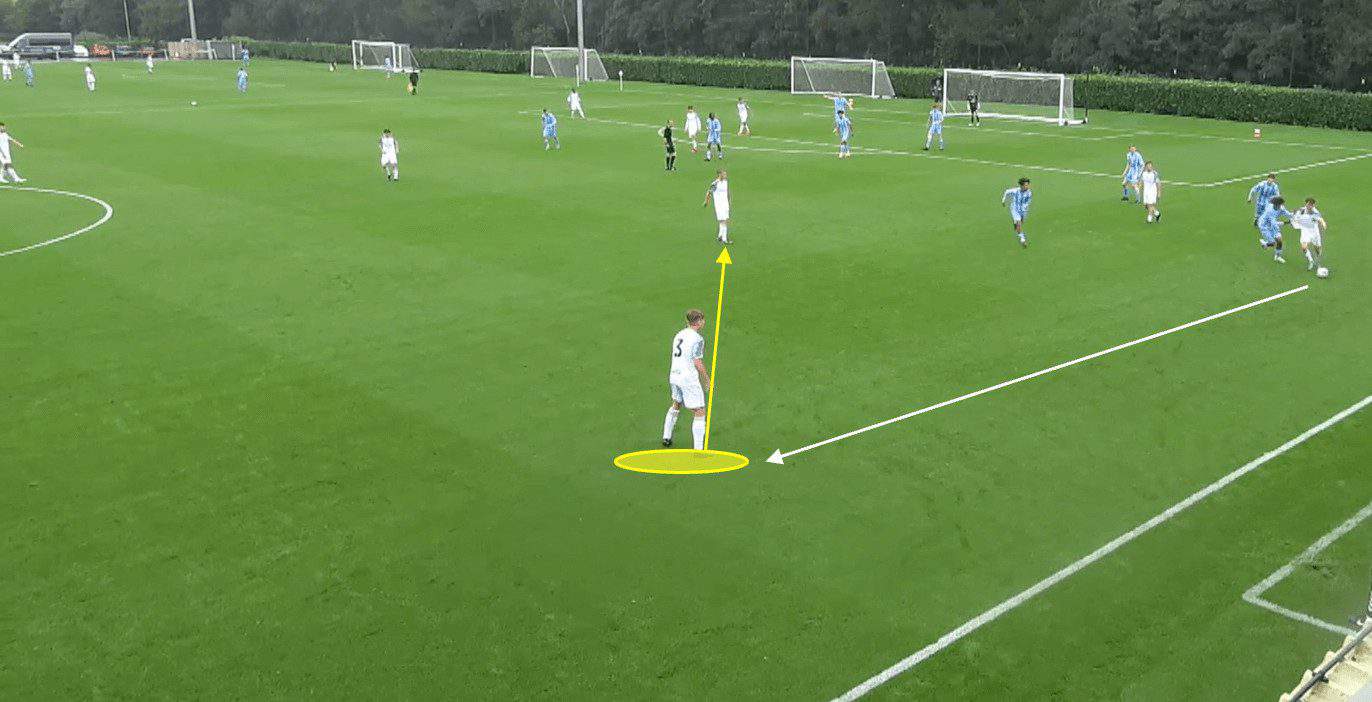
In the attacking phase, Swansea U18s look to pin their opponents back into their own half. This means The Swans can play their desired possession game as they look to use quick passing and off-the-ball movement to create spaces in the defensive structure.
Arthur Parker enables Swansea to pin their opponents back by moving high up into the opposition half, as we can see above. This means he is on hand to recycle possession and allow his team to retain possession and sustain their attack. Additionally, as we have seen, Parker is a competent ball carrier; therefore, he adds some dynamic qualities to the attacking phase and can create spaces for himself and others via his on-the-ball qualities.
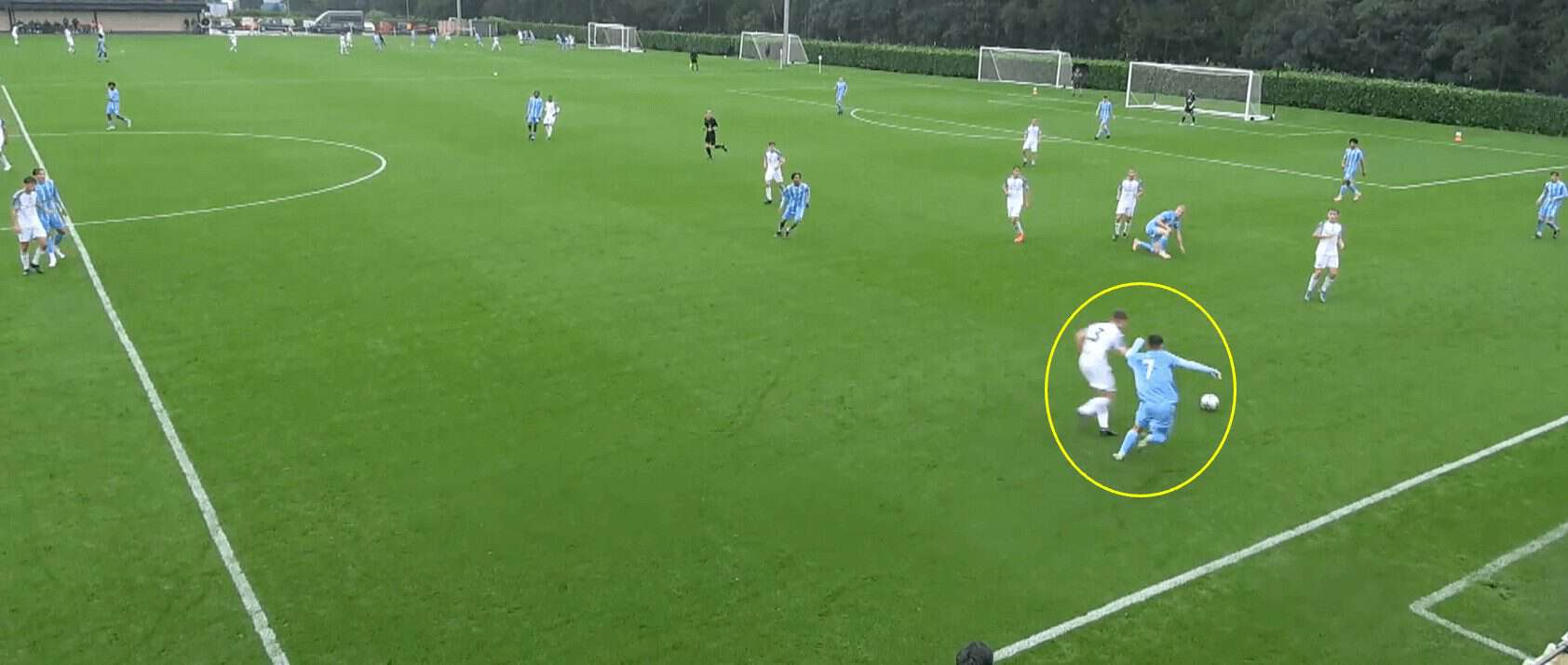
Moreover, We can see here that Parker being so high up the pitch means he can step in and regain possession when the opponent has forced a turnover and are looking to launch a counterattack. By counterpressing high up the field, the Swansea centre-back leads the team in winning back possession in advantageous areas, allowing for immediate attacking opportunities and putting the opposing team’s defence under sustained pressure.
It is worth noting that Parker can sometimes be a little too quick to step in, and this can allow the opponent to spin past him quite easily. Given his young age, this is something that can be put down to inexperience and can be fixed through coaching and put into practice as the youngster receives more game time.
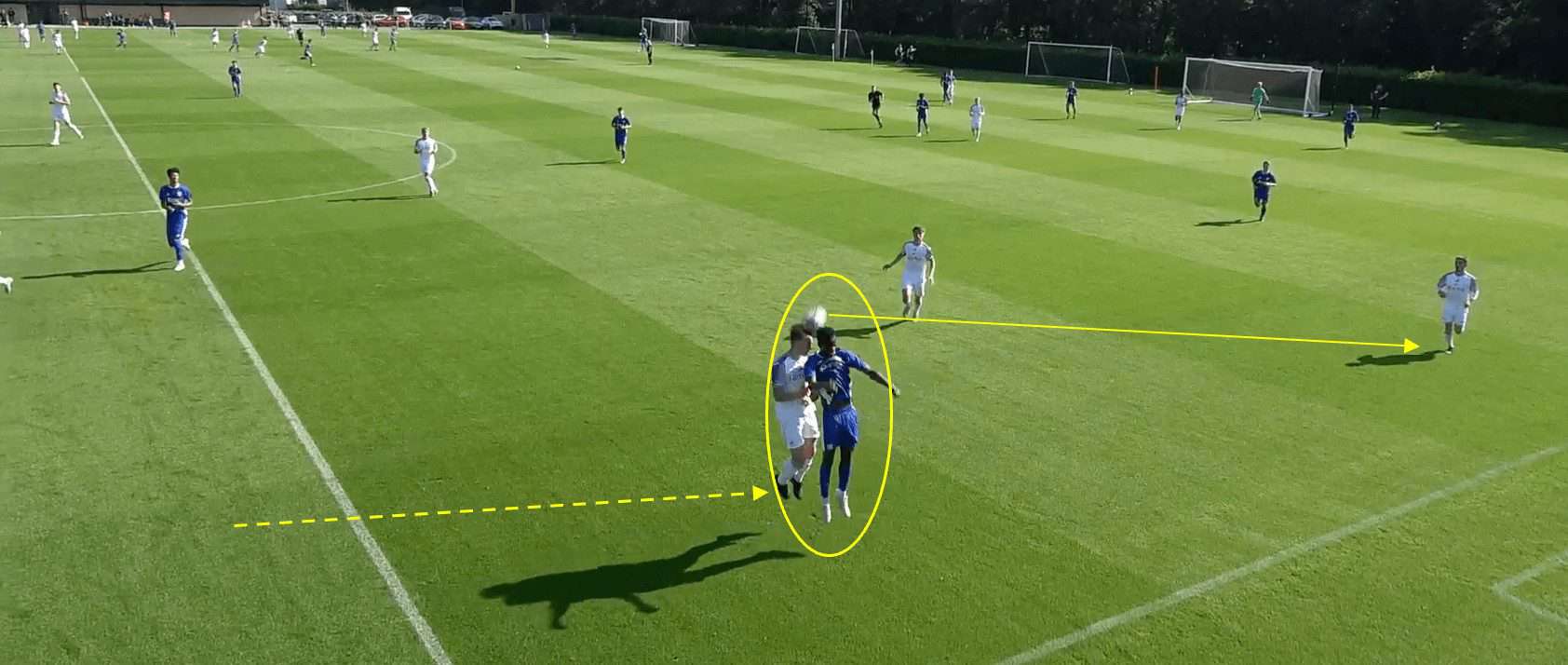
Parker possesses an excellent aerial presence; on average, he is winning 1.88 of his 2.66 aerial duels per 90. He has a good jumping reach, which enables him to outleap his opponent, as demonstrated above. The central defender is also able to generate good power and distance on his headers, mainly being able to find a teammate, ensuring his team retains possession. Defensively, Parker’s aerial ability is useful for effectively neutralising aerial threats posed by the opposing teams, particularly during set-piece scenarios such as corners, free kicks, and crosses into the penalty area.
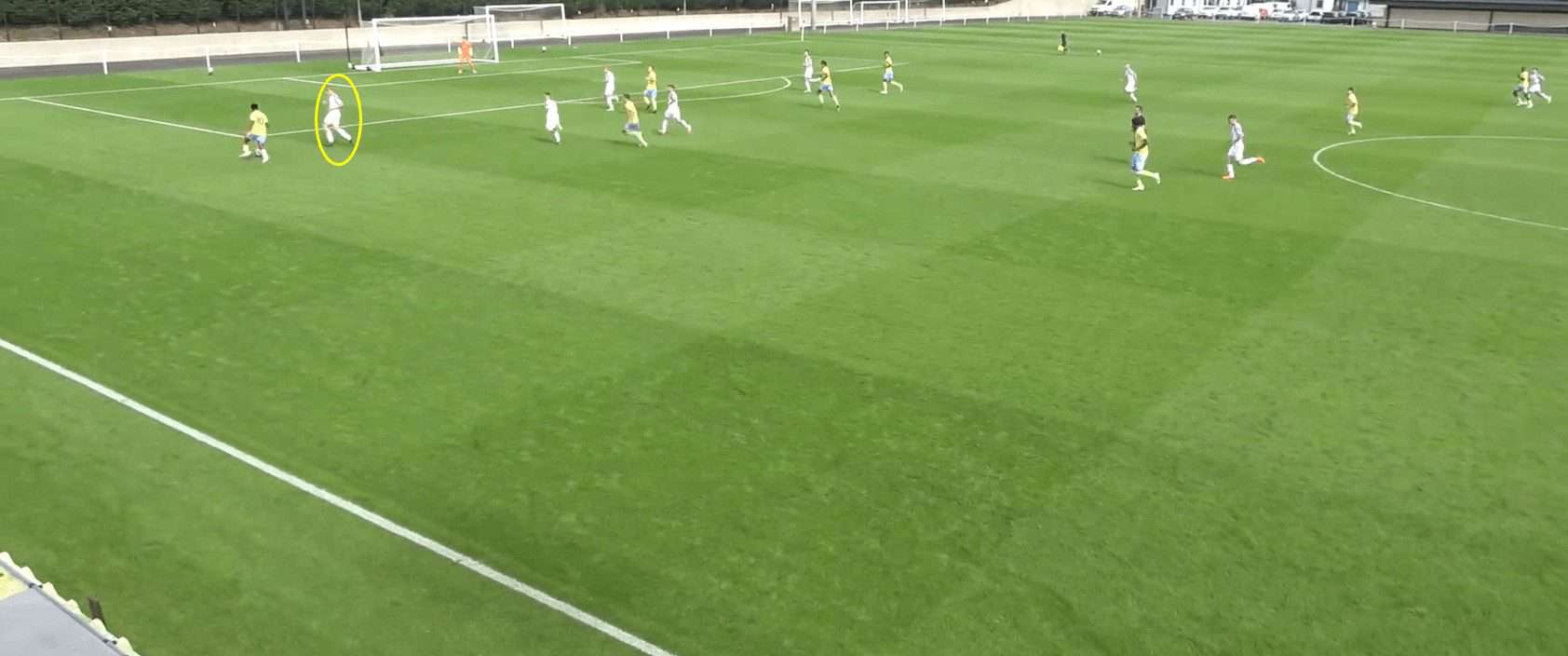
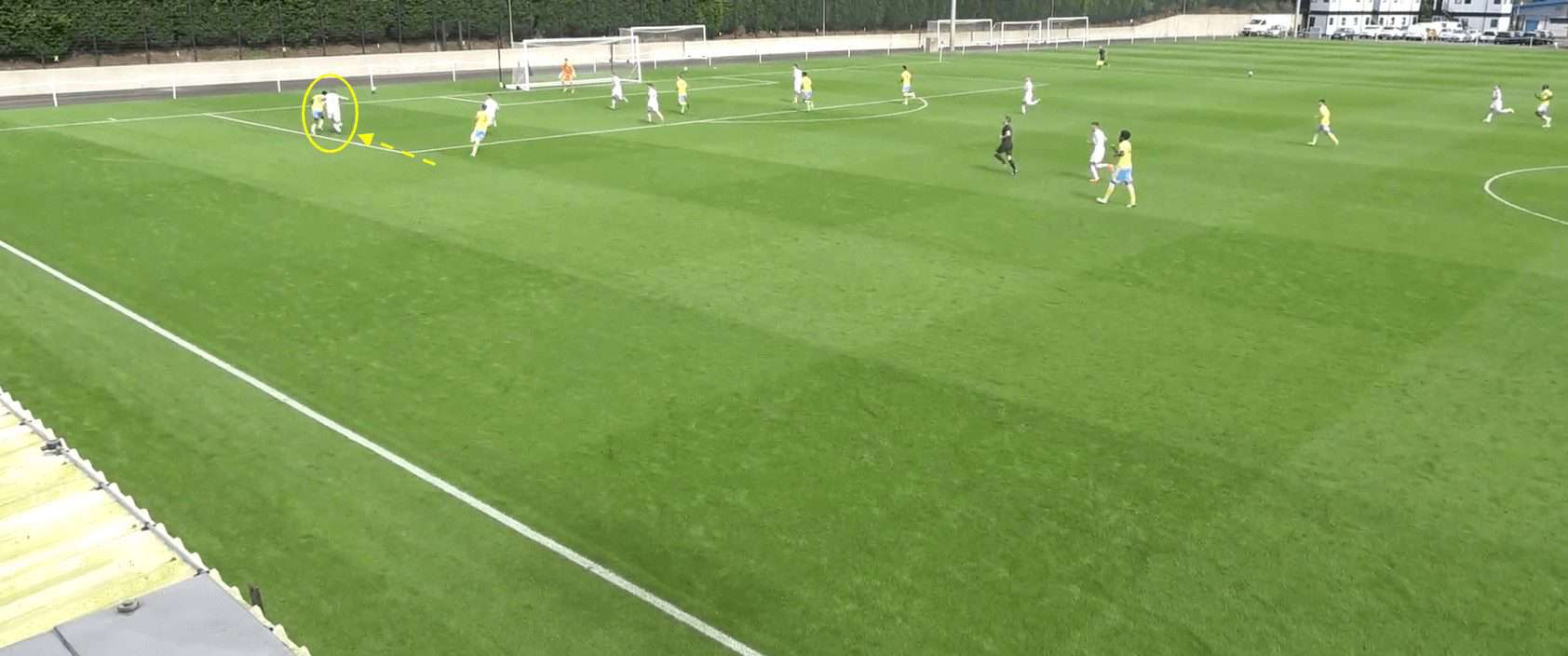
Furthermore, in terms of his defensive play, Parker displays a high level of intelligence. He rarely goes to ground, mostly preferring to use his body orientation and positioning to limit his opponent’s attacking opportunities in the 1v1s. In the scenario shown above, we can see how he calmly utilises his own strength and body orientation to prevent the opposition player from carrying the ball into a crossing position. Instead, Parker ensures he gets between the player and the ball and neutralises the attacking threat.
By reading the game well and positioning himself strategically, the central defender can effectively cut off passing lanes, allowing him to intercept the ball. As a result, he can successfully initiate counterattacks or launch very swift transitions from defence to offence. This not only disrupts the opponent’s gameplay but also allows the central defender to actively influence the team’s attacking transitions, making excellent use of his ball-playing abilities.
Tom Woodward
The next player we are going to look at in this scout report is midfielder Tom Woodward. He is a central midfielder and is very attack-minded with his style of play, and he has some qualities which show he could potentially be an outstanding number 10 in the future.
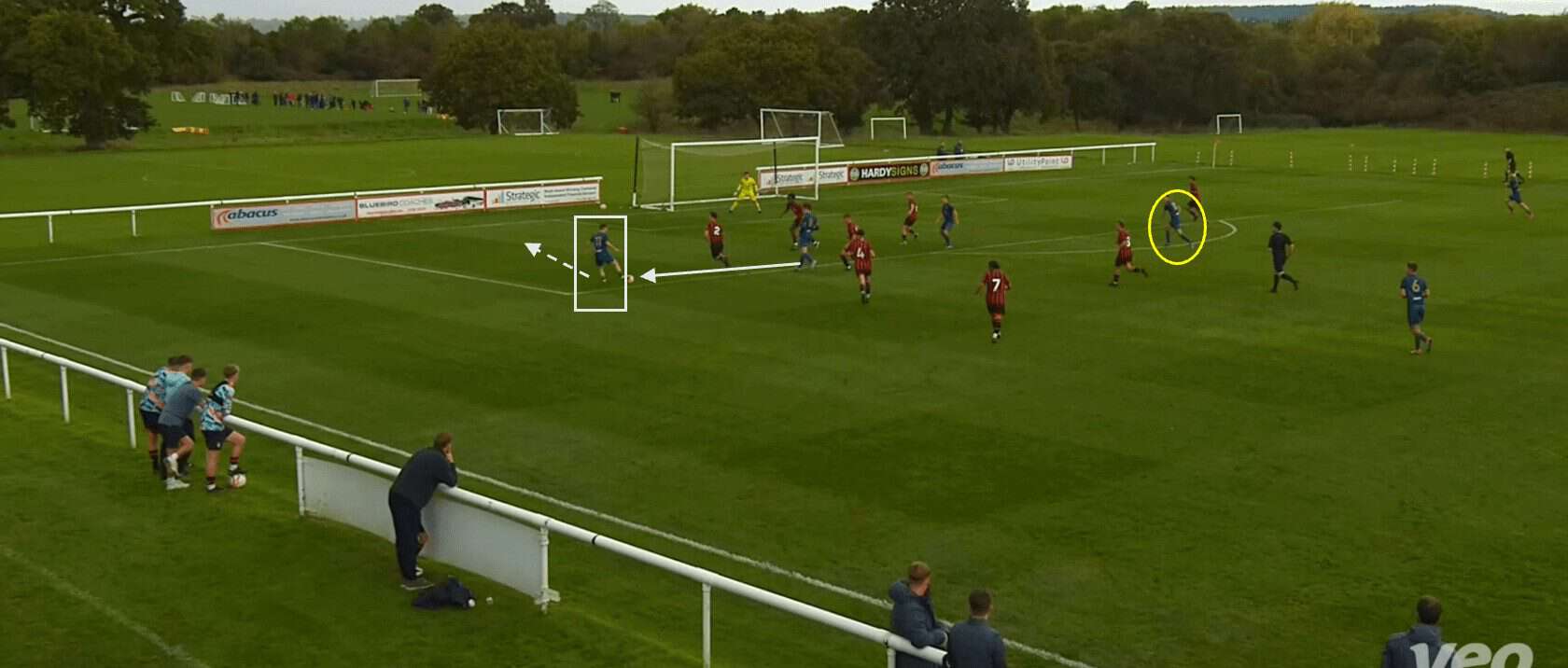
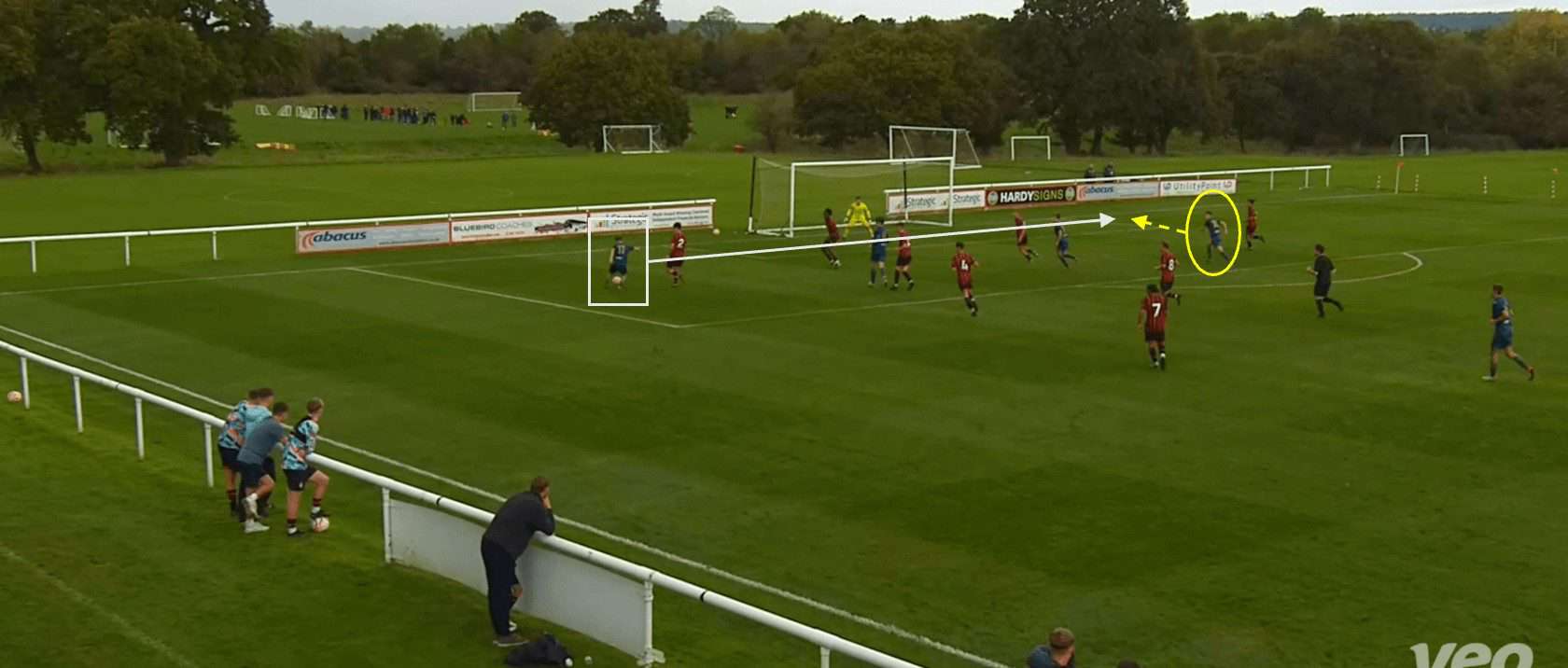
A key aspect of Woodward’s game is his ability to get himself into goalscoring positions, something which is proven by the fact that he has netted nine goals in 12 appearances so far this season, including a hat-trick against Bristol City U18s in the cup. The example above demonstrates Woodward’s runs into the penalty area as Swansea are in the attacking phase.
He identifies the space as the opposition defenders are preoccupied with marking his Swansea teammates. This allows Woodward to drift into the area with ease and calmly turn the cross into the net. He just holds his run to ensure he arrives in perfect time to connect with the ball on the first attempt.
As a central midfielder, Woodward’s ability to get into goalscoring positions really enhances the Swansea U18s overall attacking versatility and unpredictability. By displaying an aptitude for arriving in goalscoring areas, he automatically becomes an unexpected threat. This could catch the opposition off guard, as we see above, introducing an element of surprise to Swansea’s attacking manoeuvres.
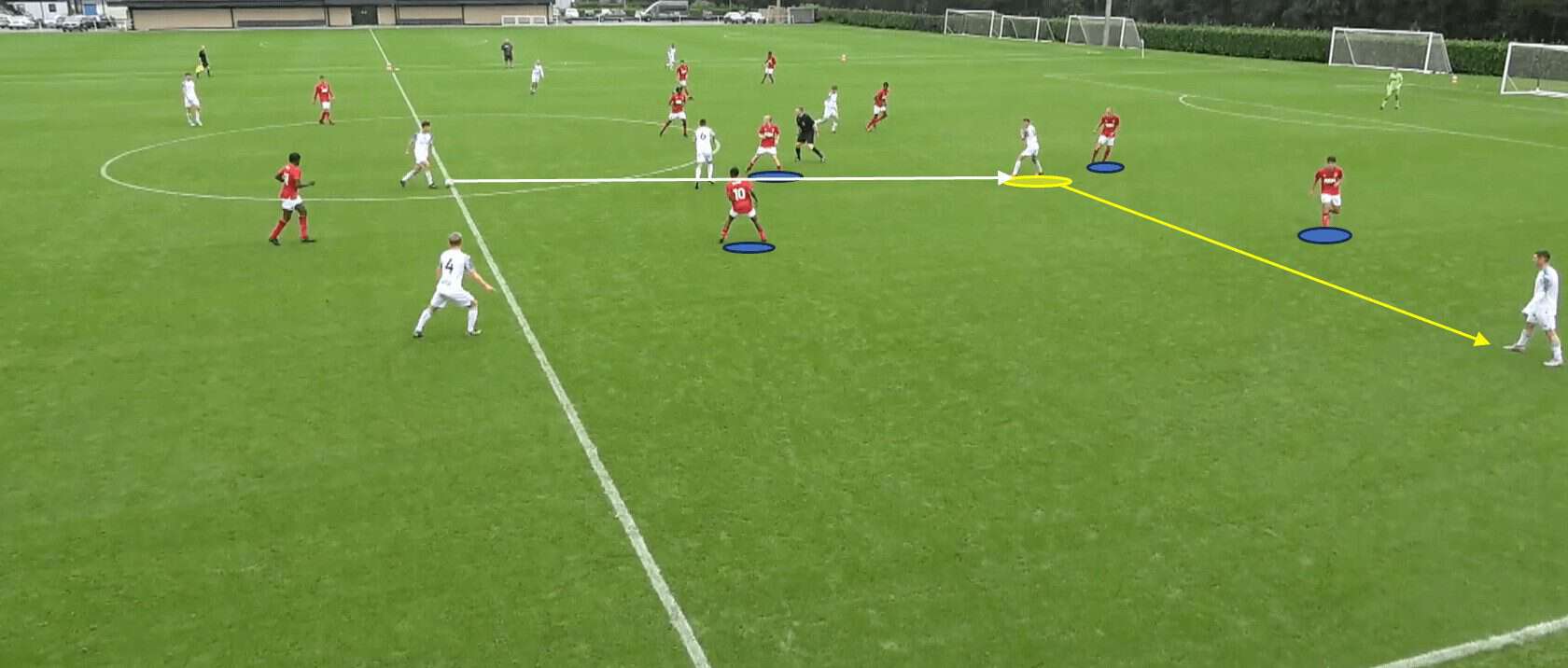
Woodward likes to receive the ball between the lines, often positioning himself in pockets of space between the opposition’s defensive and midfield lines. He is continuously scanning, which means he is very aware of the positioning of the opponents and his teammates. Additionally, the midfielder is comfortable receiving the ball on the turn and will often use his agility and body orientation to create space for himself.
In this example, the young midfielder receives the ball with his back to goal and his body orientation facing slightly to his right side. He uses his first touch to bring the ball across him, creating space and then passes the ball out wide to his teammate.
Receiving the ball between the lines allows him to exploit the spaces in the opposition’s defensive structure and creates opportunities to turn and face the opposition’s goal. Woodward’s ability to position himself adeptly in these pivotal areas means that he can receive passes from teammates in areas where he has more time and space to assess his options and execute decisive passes that can potentially unlock the opposition’s defensive line and create goalscoring opportunities for teammates.
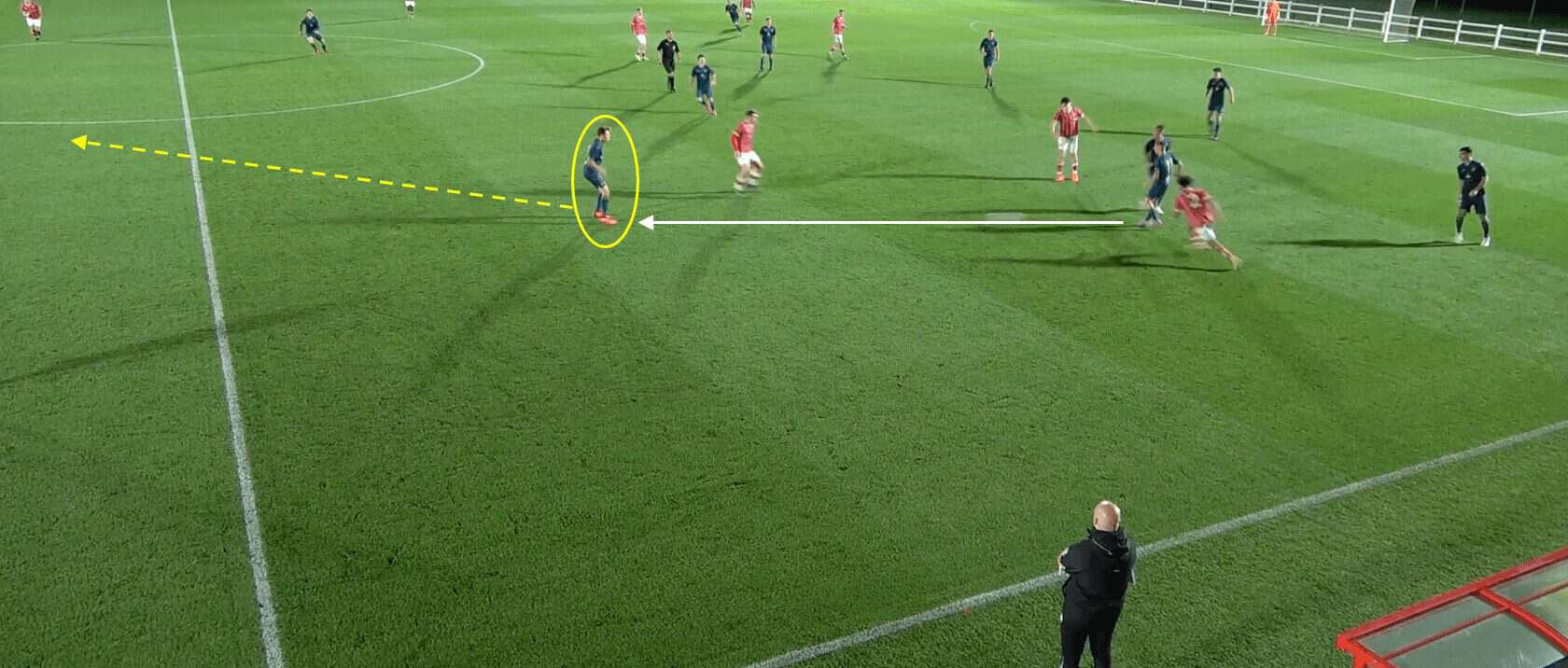
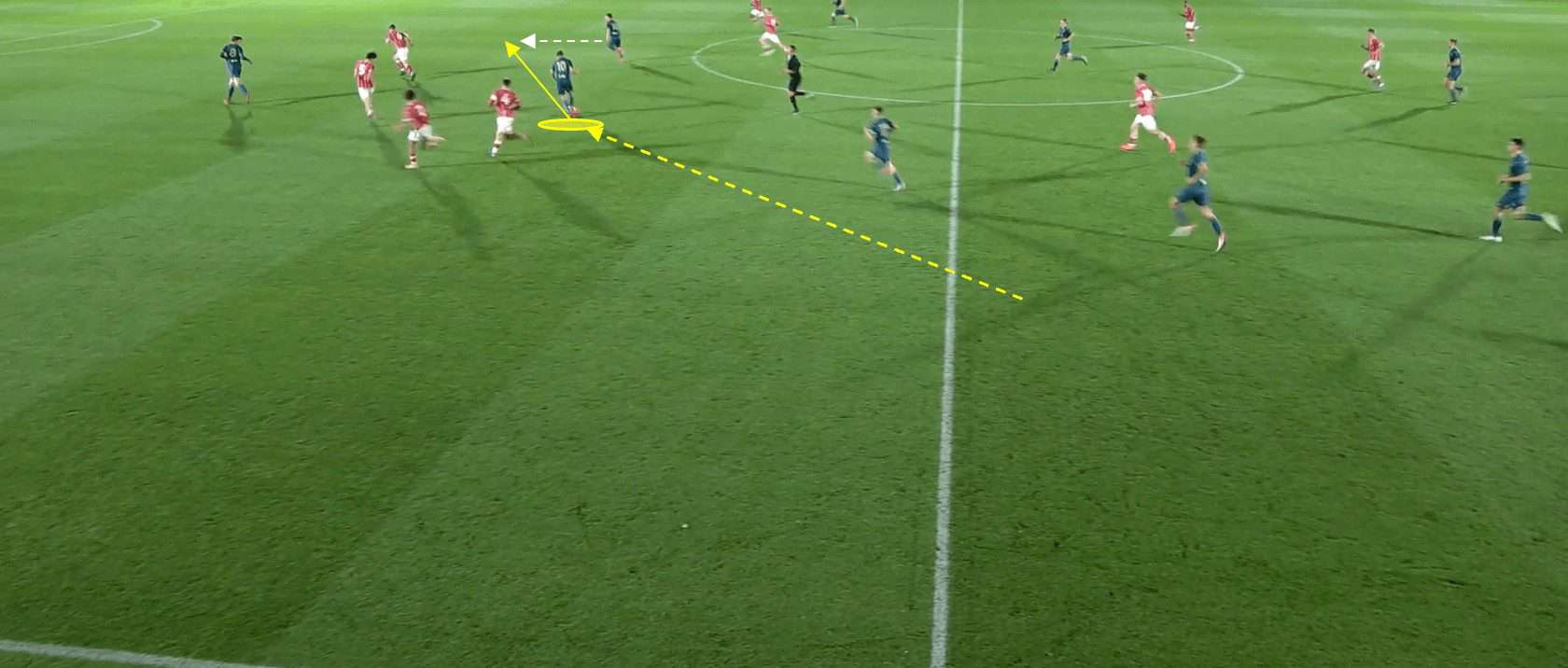
Furthermore, Woodward is often the player that Swansea U18s look to in the transition from defence to attack. He has a tremendous ball-carrying ability, is comfortable in possession and can cover the ground very quickly, which means The Swans have the ability to counterattack at speed. Woodward serves as the link who is responsible for connecting the defensive and attacking phases of the game, as he can effectively transition the team and use his creativity to form an attacking threat.
His ball-carrying ability also contributes to the team’s ability to retain possession and means that he can control the tempo during transitional phases. Woodward can navigate through opposition players and retain possession using his close control and quick feet in critical areas of the field, allowing Swansea to build attacking sequences and ultimately control the rhythm of the game.
This really does limit the opposition’s attempts to regain possession but also provides Swansea with the necessary time and space to orchestrate cohesive attacking movements and create goalscoring opportunities in the final third.
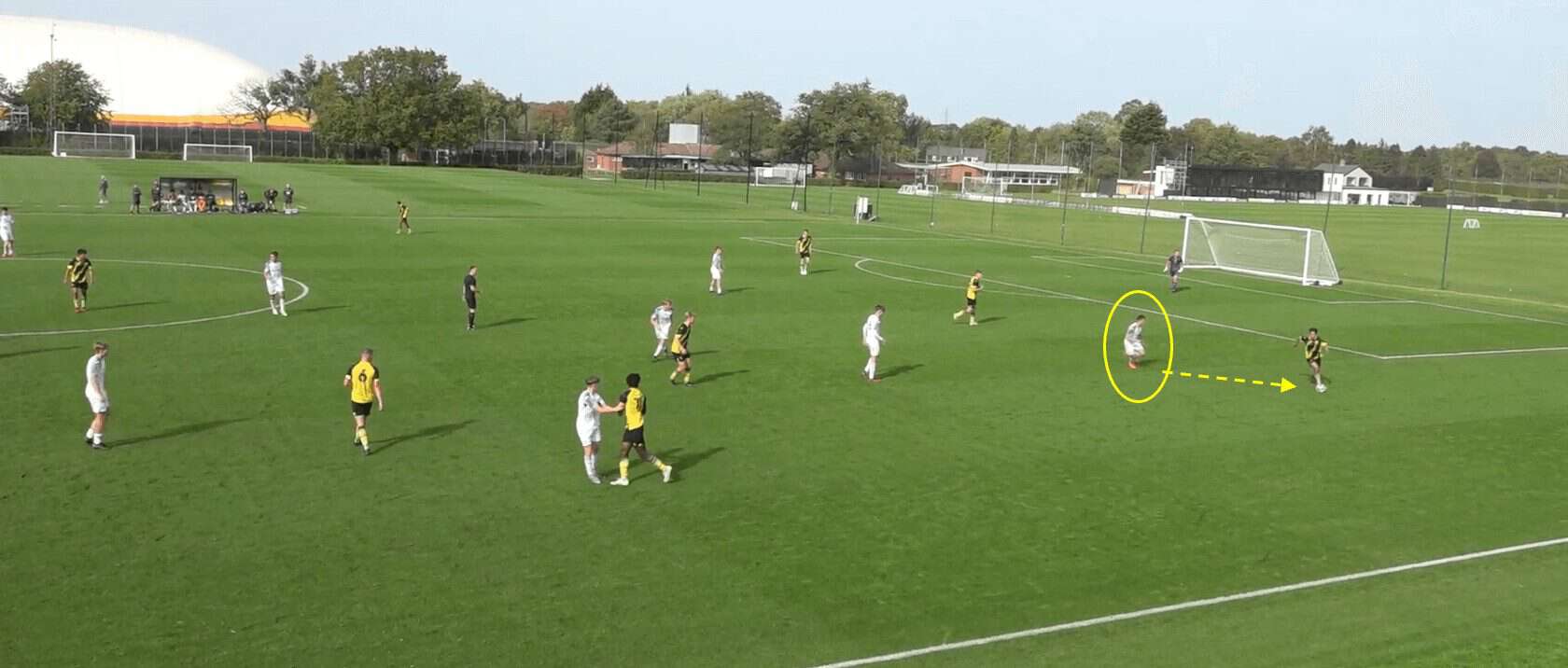
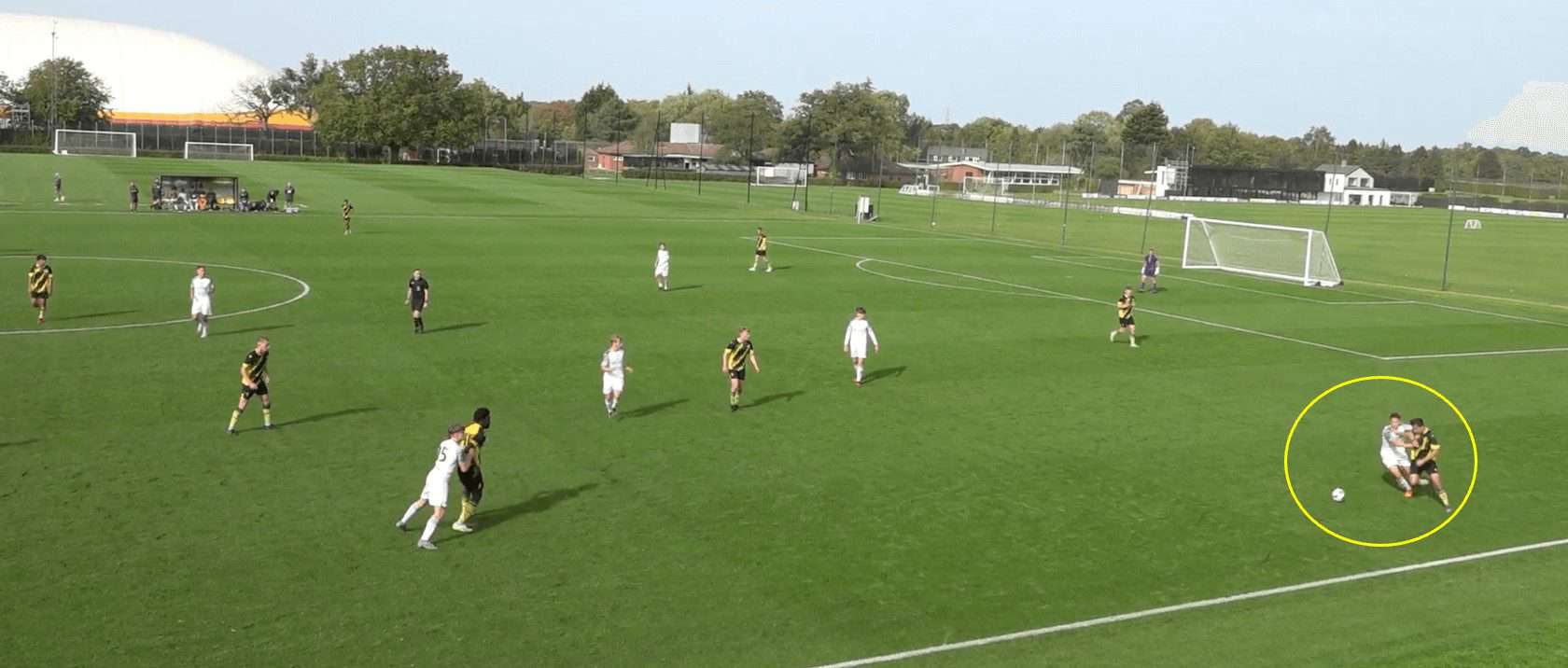
From a defensive standpoint, Swansea U18s like to counterpress, looking to regain possession as high up the pitch as possible. Here, we can see this in action. He is quick to initiate the press and close down his opponent. Woodward then uses his strength to regain possession and play it back to a teammate.
His willingness to work hard and press high means it enables Woodward to apply immediate pressure on the opposition, often forcing them into making hasty decisions and potentially committing turnovers in dangerous areas of the field, as shown above. By actively countering the opposition’s attempts to progress the ball, he can create turnovers that can immediately lead to goalscoring opportunities, thereby increasing the team’s chances of scoring goals and maintaining sustained attacking pressure.
Sammy Henia-Kamau
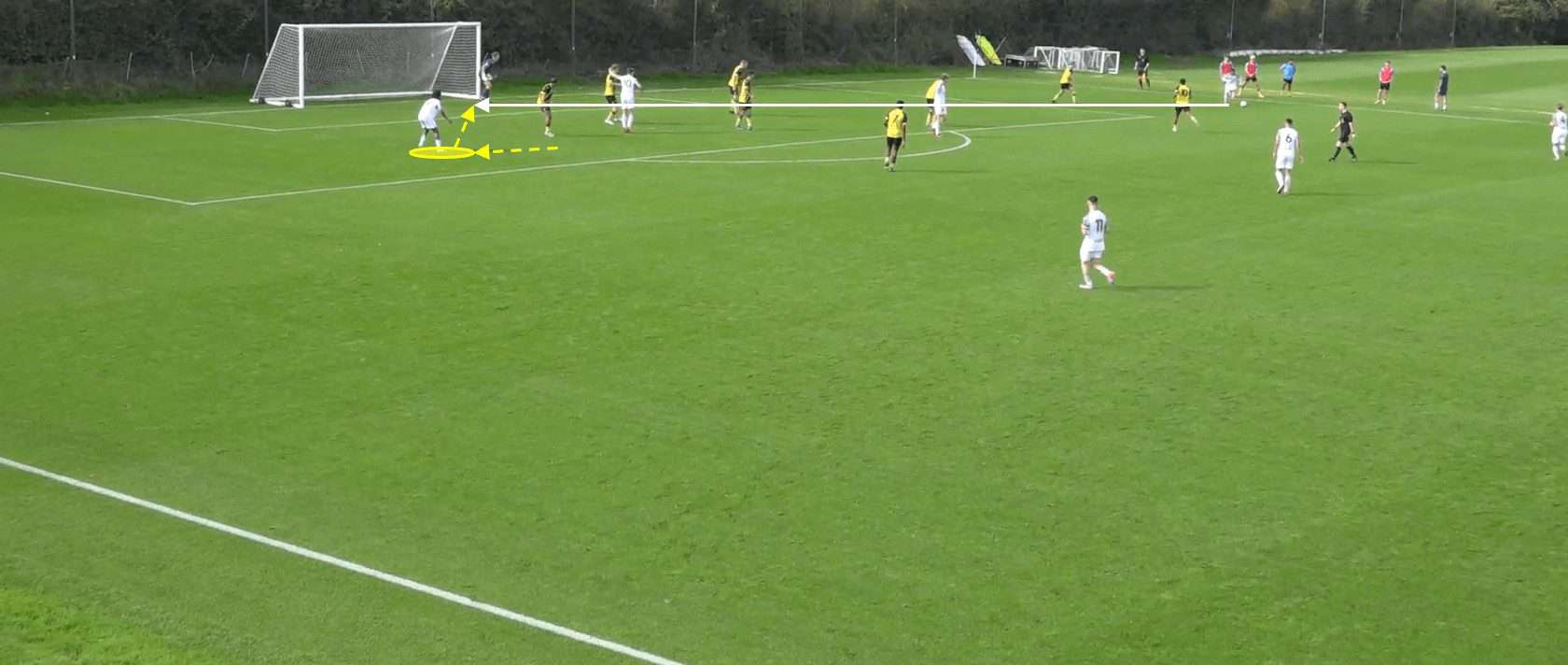
Sammy Henia-Kamau is a dynamic and versatile forward with a real striker’s instinct for finding pockets of space to create optimal goalscoring opportunities for himself. We can see in this example that he is able to lose his marker and create space for himself, which enables his teammate to fire a cross into the penalty area, and Henia-Kamau is on hand to turn it goalwards.
Taking a few subtle steps back whilst his opponent is anticipating the cross enables the centre forward to become a more effective target for his teammate to aim for and is a big part of why he has scored five goals so far this season. By intelligently moving into open spaces and exploiting gaps in the opposition’s defensive line, the centre-forward can position himself optimally to receive accurate crosses and through balls, subsequently increasing the team’s chances of scoring goals from well-timed headers or shots on target.
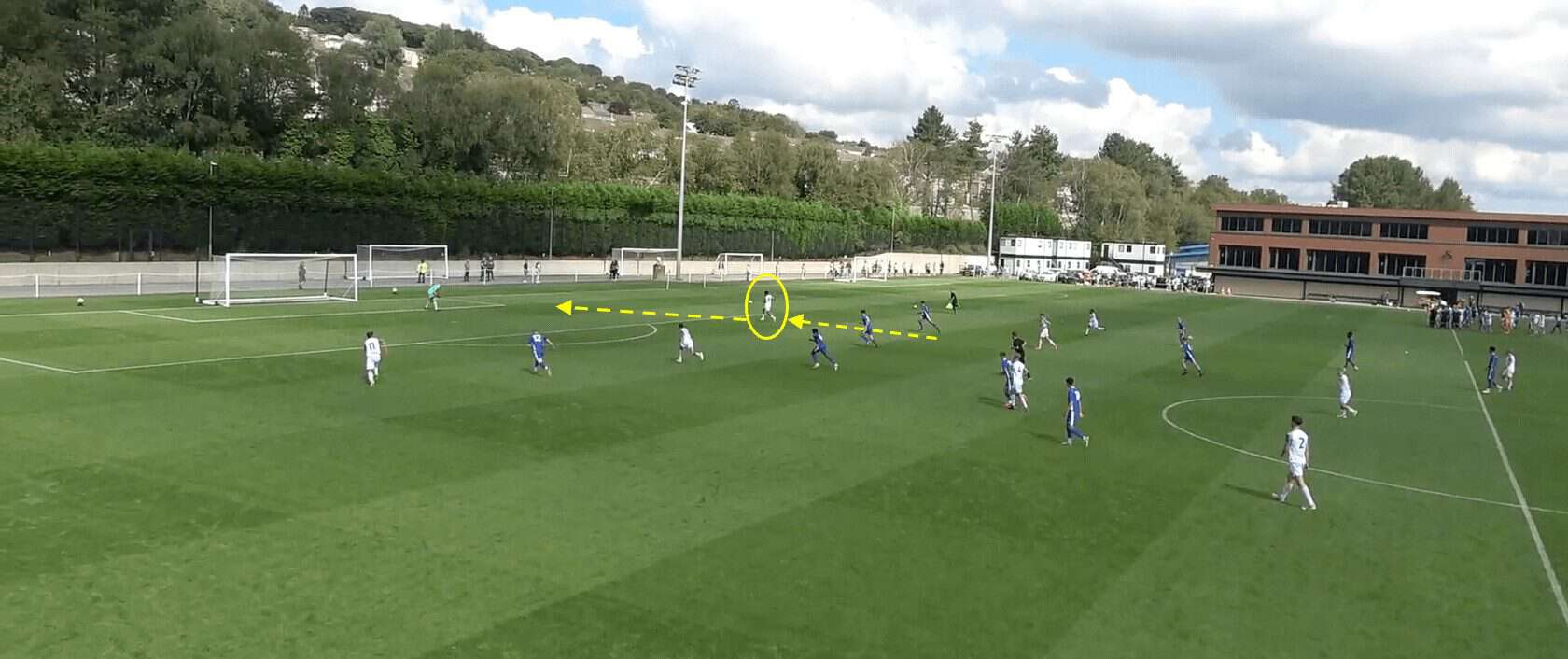
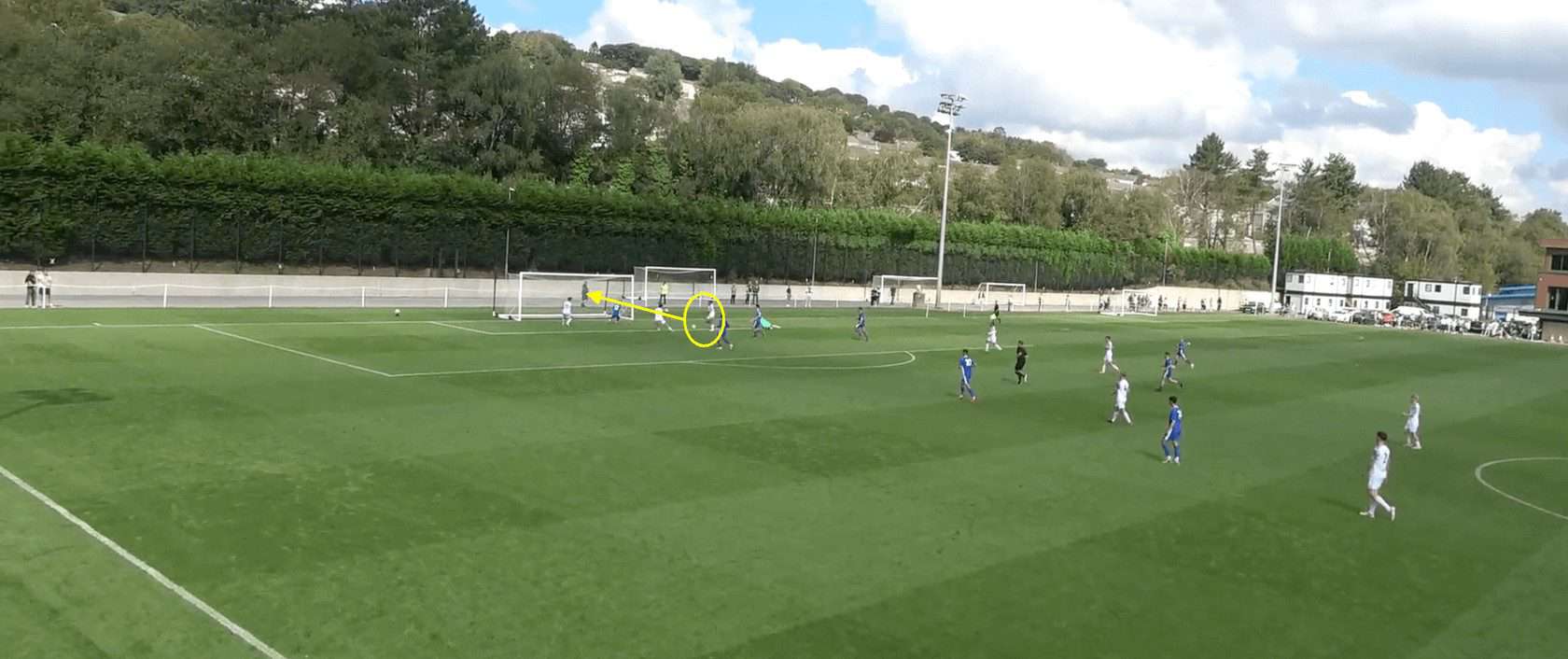
Henia-Kamau is a relatively new face in the Swansea academy, having joined the Under 18s in July from Jersey Bulls. However, this doesn’t faze him one bit as he is not short of confidence and exudes calmness and composure in front of goal. In this example, he has made an excellent run in behind the opposition defensive line thanks to his electric speed. Upon receiving the ball, the young forward drives into the penalty area and finds himself 1v1 with the goalkeeper. Henia-Kamau does not panic and simply sidesteps the goalkeeper and passes the ball into the empty net.
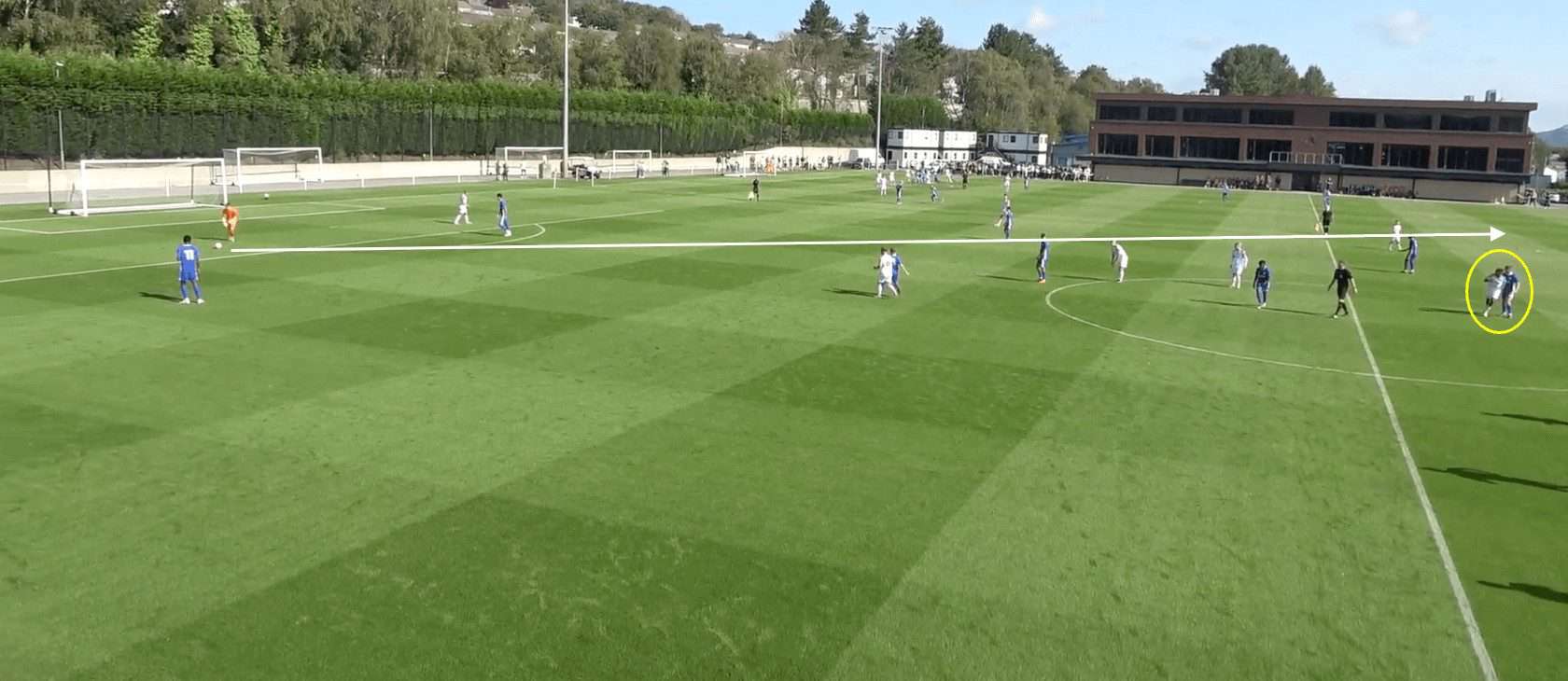
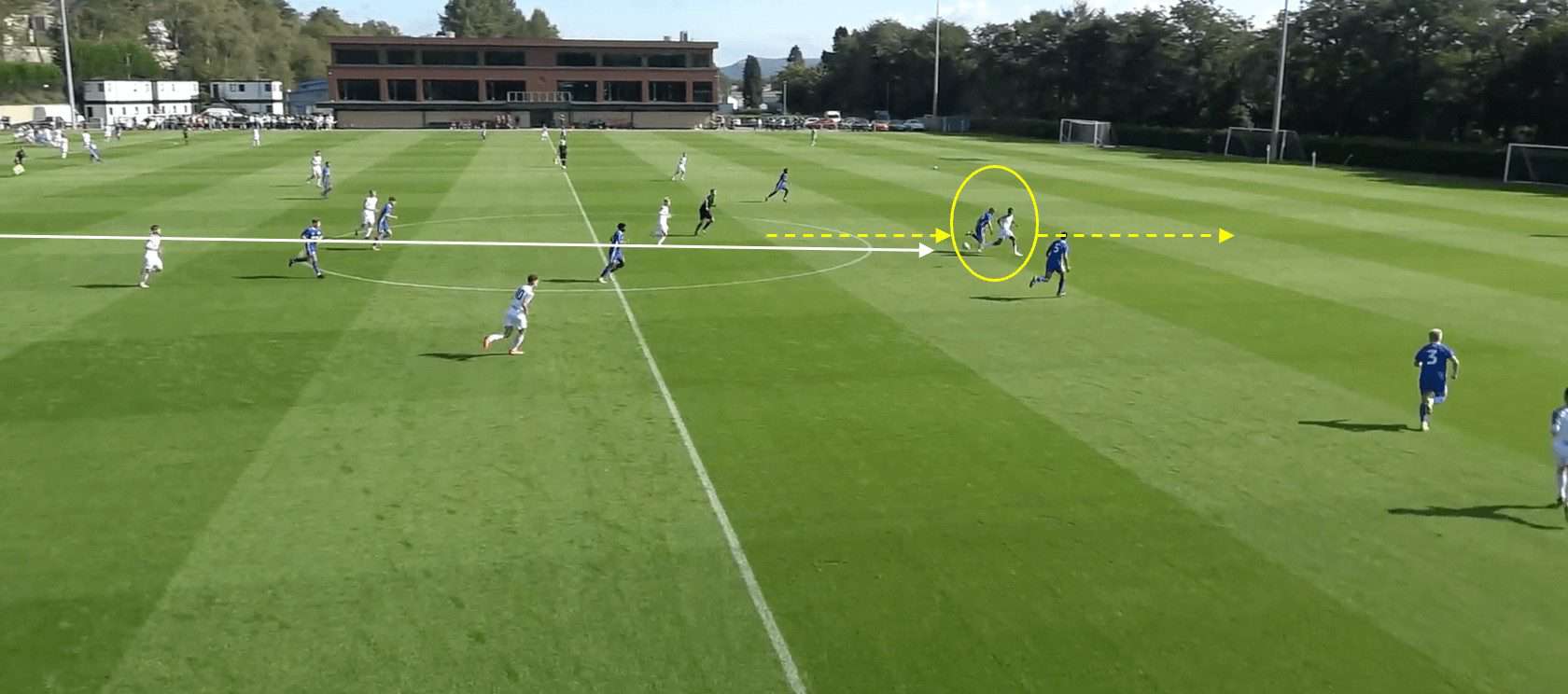
Moreover, we mentioned Henia-Kamau’s speed briefly in the section above; this is something that Swansea U18s look to harness throughout games at various points. Typically, the team will look to build an attack from the back. However, they do look to find various ways to catch their opponents off guard.
In this instance, the goalkeeper plays a long pass in behind the opposition defence. Henia-Kamau is incredibly adept at pinning and spinning his maker. As a result, he can use his strength to hold off his opponent and carefully arch his run, which allows him to accelerate away at speed. This is an excellent way of utilising the dynamic forward’s athleticism and well-timed runs in behind.

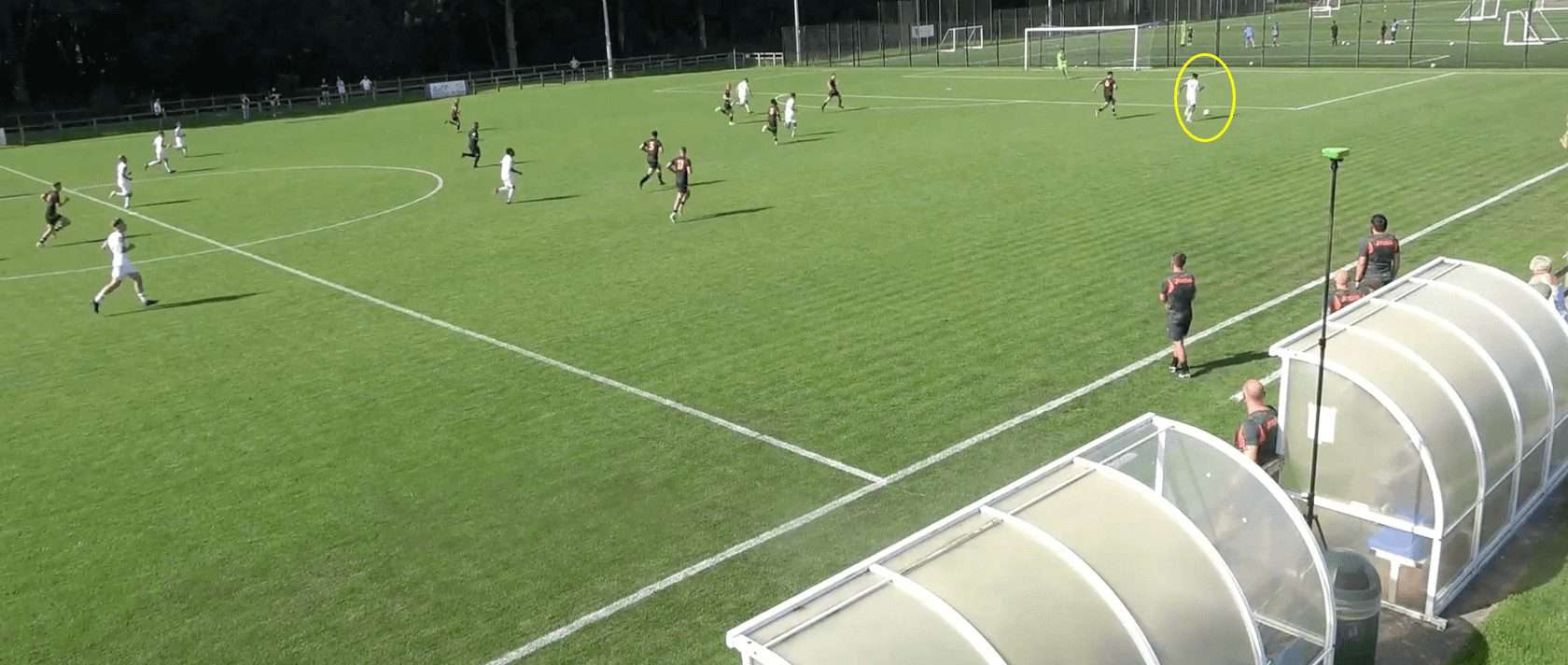
Additionally, the Swansea U18 forward uses his speed and off-the-ball movement to work the half-spaces and channels well. Making these runs into the wide areas enables the young centre forward to become a more versatile attacking threat, allowing him to operate different areas of the pitch and participate in intricate combination play with the wingers and full-backs.
Here, Henia-Kamau makes a run into the right half-space and uses his speed to accelerate away from his opponent. This shows that he can get into an optimal crossing position, which means he can actively contribute to the team’s build-up play. Significantly, this diversifies Swansea’s attacking options and creates a multifaceted offensive approach that keeps the opposition’s defence constantly on their toes.
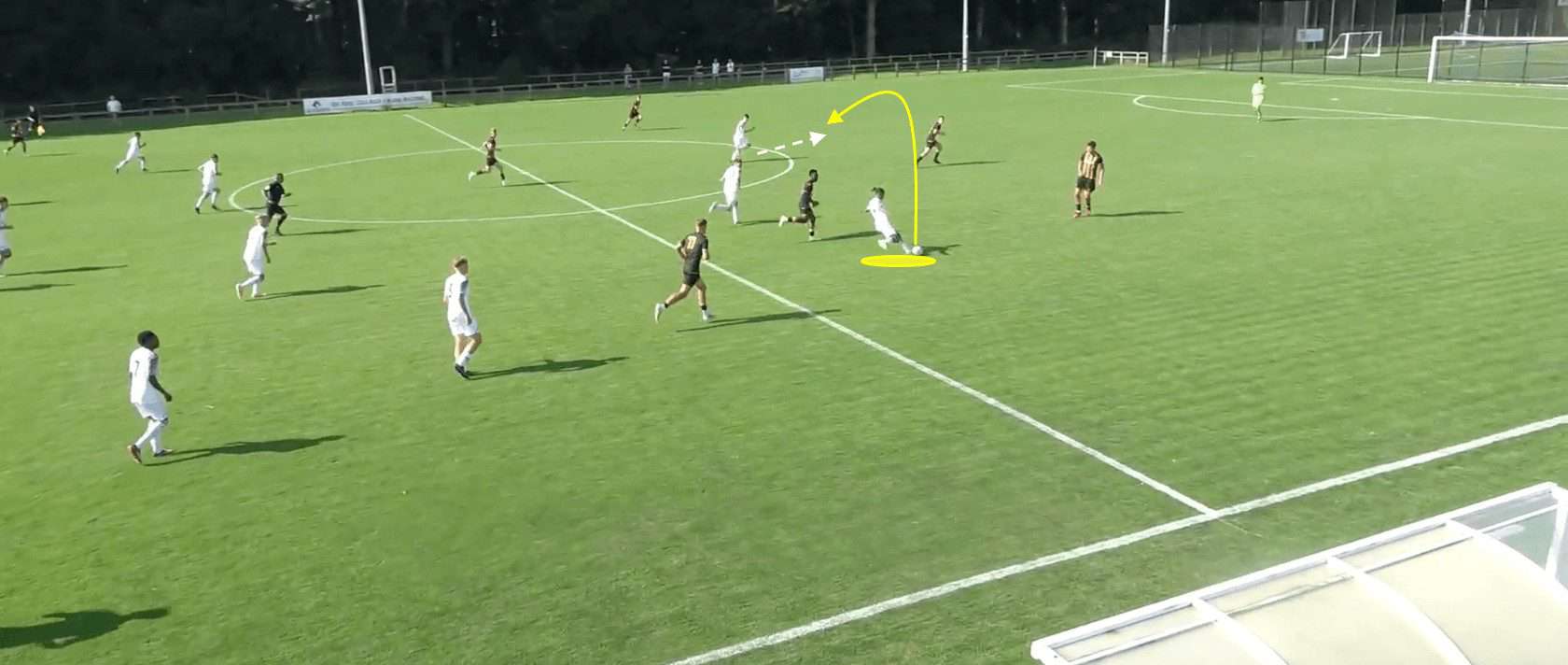
Furthermore, the young centre forward’s intelligent off-the-ball movement sees him drop deeper to link up play quite frequently. We can see here that he drops back to receive the ball, allowing his teammate to make a run forward. Henia-Kamau can then play a lofted pass into the path of the Swansea player.
By dropping off to pick up possession, it entices the opposition defenders to follow Henia-Kamau, which, in turn, creates spaces that his teammates can exploit with their off-the-ball movements. Alternatively, the striker can receive the ball in space, drive forward, utilise his dribbling skills, and create goalscoring opportunities for himself and others.
His capacity to instigate dynamic attacking movements such as this demonstrates that Henia-Kamau can catch the opposition off guard and increase the likelihood of Swansea U18s finding the back of the net.
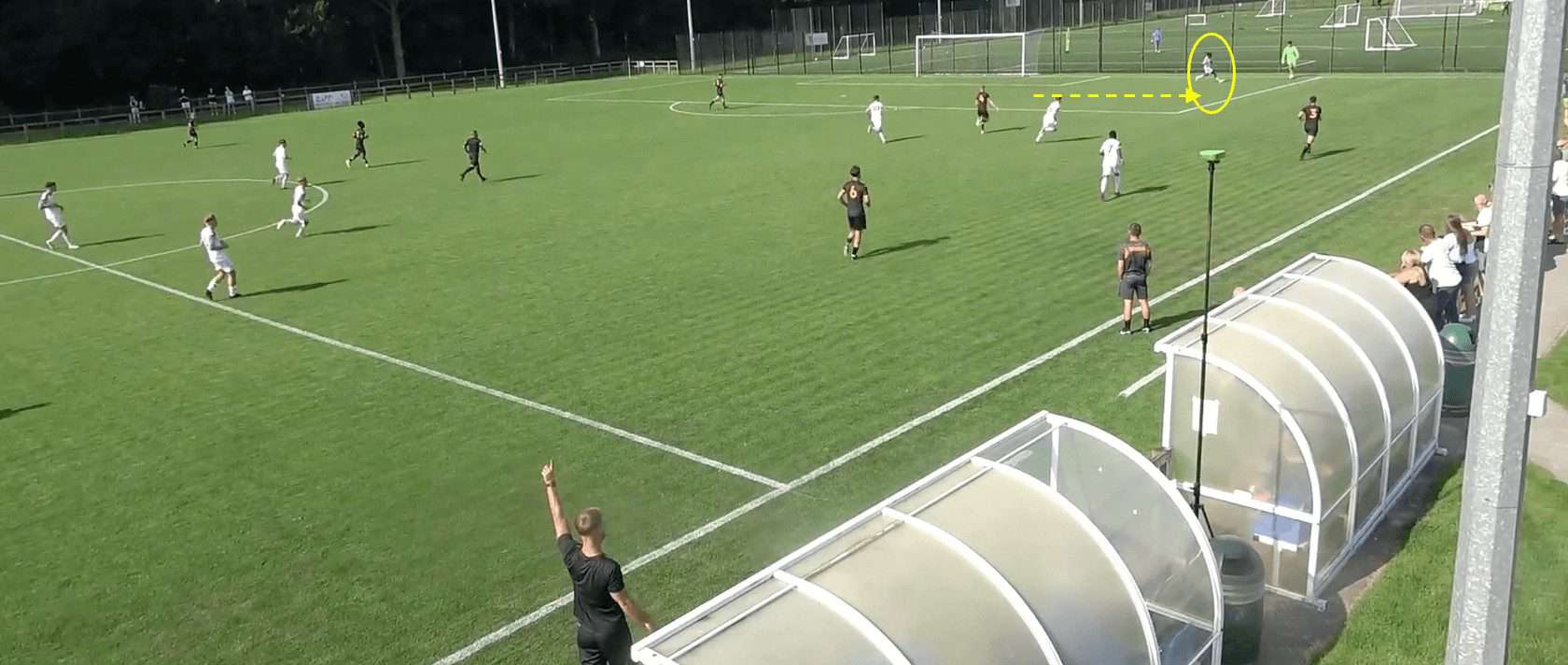
Plus, Sammy Henia-Kamau puts his dynamism to good use in the defensive phase by leading the Swansea U18s press very well. He instinctively moves to close down the opposition. As we can see in the example above, he puts the goalkeeper under an immense amount of pressure. Consequently, this forces him to rush his kick.
It is tenacious defensive work such as this which leads to forcing the opponents into errors and creates turnovers high up the pitch. Plus, this also serves to disrupt the opposition’s rhythm and prevent them from establishing a sustained period of possession and offensive dominance.
Conclusion
In this scout report, we have analysed three academy players currently in Swansea City’s youth system. The club has a well-documented history of bringing talented youngsters into the first team.
Arthur Parker, Tom Woodward and Sammy Henia-Kamau are three players to look out for in the future. We have taken a look at each player’s individual style of play in addition to assessing what they bring to the current Swansea Under 18s team.
All three of the players in this tactical analysis look to have a very bright future ahead of them. Realistically, they could all follow in the footsteps of Joe Allen, Ben Davies and, more recently, Ben Cabango.





Comments